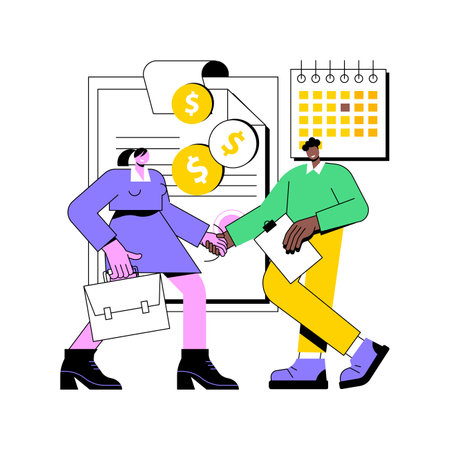Introduction to Employer-Sponsored Retirement Plans
When it comes to building a strong nest egg for retirement, employer-sponsored plans are a cornerstone for millions of Americans. These plans, offered through the workplace, are designed to help employees save and invest for their future, especially as they approach the later stages of their careers. Let’s break down what these plans are, how they work, and why they matter so much in the U.S.
Understanding the Basics
Employer-sponsored retirement plans are savings vehicles set up by employers to help employees prepare financially for retirement. The most common types include 401(k)s, 403(b)s, and a few others that serve specific groups of workers. These plans often come with unique features—like tax benefits and employer contributions—that make them especially valuable compared to saving on your own.
Common Types of Employer-Sponsored Plans
| Plan Type | Who It’s For | Main Features |
|---|---|---|
| 401(k) | Most private sector employees | Pre-tax or Roth contributions; often includes employer match; annual contribution limits |
| 403(b) | Public school employees, certain non-profits | Similar to 401(k) but tailored for public/non-profit workers; tax-deferred growth |
| 457(b) | State/local government employees | No early withdrawal penalty for separation from service; additional catch-up options |
| SIMPLE IRA/SEP IRA | Small businesses/self-employed | Lower administrative costs; flexible contribution rules; tax advantages |
The Foundation of American Retirement Savings
In the U.S., Social Security alone is rarely enough to cover all expenses in retirement. That’s where employer-sponsored plans step in. With automatic payroll deductions, it’s easy for workers to steadily build savings over time—often without having to think much about it. Many employers also offer matching contributions, which is essentially free money added to your account just for participating.
Why These Plans Matter in Late-Stage Saving
The closer you get to retirement age, the more important these plans become. They offer opportunities to ramp up contributions through “catch-up” provisions for those aged 50 and over. Plus, investment choices within these plans can help your money grow faster than it would sitting in a regular savings account.
2. Why Late-Stage Retirement Saving Matters
When it comes to retirement savings, the final decade before you leave the workforce is a game-changer. Whether you’re catching up or building on years of diligent saving, this period holds unique importance for your future security. Employer-sponsored plans—like 401(k)s, 403(b)s, and similar programs—can play a critical role in making the most out of these years.
The Crucial Last Decade: What Makes It So Important?
Late-stage retirement saving (usually from ages 55 to 65) is your last chance to boost your nest egg. Why does it matter so much?
- Peak Earnings: Most people earn their highest salaries in their late careers, meaning you can contribute more to your employer plan.
- Catching Up: The IRS allows “catch-up contributions” after age 50, giving you a bigger opportunity to save more each year.
- Compound Growth: Money invested now still has time to grow before withdrawals begin.
- Refining Goals: You have a clearer picture of what you’ll need for retirement—so you can adjust your savings targets accordingly.
Comparing Early vs. Late-Stage Retirement Saving
| Early Stage (20s-40s) | Late Stage (55+) | |
|---|---|---|
| Savings Priorities | Building habits, long-term growth | Maximizing contributions, minimizing risk |
| Contribution Limits | Standard annual limits | Higher limits with catch-up options |
| Risk Tolerance | Higher (longer time horizon) | Lower (protecting what youve built) |
| Financial Focus | Diversification, aggressive growth | Preservation, income planning |
| Tactical Moves | Automate savings, invest in stocks | Bump up 401(k), shift toward bonds/fixed income |
The Unique Challenges in the Final Decade Before Retirement
- Catching Up Quickly: If you haven’t saved enough earlier, you may feel pressure to turbo-charge your savings in a short time frame.
- Navigating Market Volatility: Sudden downturns can have a bigger impact when you’re close to retirement and have less time to recover.
- Healthcare Costs: Planning for higher medical expenses becomes essential as retirement approaches.
- Tough Decisions: Choices about Social Security timing, pension options, and when to retire all pile up during these years.
- Avoiding Withdrawals: Withdrawing too soon can lead to penalties and reduce long-term growth potential.
The Bottom Line: Take Advantage of Your Employer-Sponsored Plan
Your employer-sponsored plan is designed to help you ramp up savings efficiently during these crucial years. By understanding the opportunities and challenges unique to late-stage saving, you can make smart moves that set the stage for financial freedom when it matters most.

3. Key Features That Support Late-Stage Savers
Catch-Up Contributions: Giving Your Savings a Boost
When you hit age 50, employer-sponsored retirement plans like 401(k)s and 403(b)s let you make “catch-up” contributions. This means you can put in extra money above the regular annual limit. For example, in 2024, the standard 401(k) contribution limit is $23,000, but if youre 50 or older, you can add an extra $7,500. This is a big help for those who want to ramp up their savings as retirement gets closer.
| Plan Type | Standard Contribution Limit (2024) | Catch-Up Amount (Age 50+) | Total Possible Contribution |
|---|---|---|---|
| 401(k), 403(b) | $23,000 | $7,500 | $30,500 |
| SIMPLE IRA | $16,000 | $3,500 | $19,500 |
| Traditional IRA/Roth IRA | $7,000 | $1,000 | $8,000 |
Employer Matching: Free Money for Your Future
Many employers offer a matching program—basically free money added to your retirement savings when you contribute to your plan. For example, your employer might match 50% of what you put in, up to a certain percentage of your salary. If you maximize both your own contributions and the match, your nest egg can grow much faster. It’s important to understand how your company’s match works so you don’t leave any dollars on the table.
Profit-Sharing: Sharing Company Success with You
Some companies add even more by sharing profits with employees through their retirement plans. Profit-sharing contributions are extra funds that your employer deposits into your account based on the companys yearly performance. These amounts can vary each year and aren’t tied to how much you personally contribute. It’s another way late-stage savers can see bigger jumps in their retirement balances as they near the finish line.
Other Helpful Plan Features for Late-Stage Savers
- Automatic Contribution Increases: Some plans let you automatically increase your savings rate each year—great for growing your balance without thinking about it.
- Roth Options: Many employer plans offer Roth accounts where you pay taxes now but withdraw funds tax-free in retirement—a smart choice for some late-stage savers.
- Financial Education & Advice: Employers often provide access to financial tools and advice that can help you make the most of these features and adjust your strategy as retirement approaches.
A Quick Comparison of Key Plan Features for Late-Stage Savers:
| Feature | Main Benefit | Who Can Use It? | Why It Matters for Late-Stage Saving? |
|---|---|---|---|
| Catch-Up Contributions | Bigger annual limits after age 50 | Savers age 50+ | Makes up for years with lower savings; turbocharges last-minute efforts |
| Employer Match | Doubles your money up to a set percentage of salary | All eligible employees who contribute enough to get the full match | Puts “free” money into your account; accelerates growth especially as retirement nears |
| Profit-Sharing | Extra contributions from company profits—not tied to employee input | Depends on employer plan rules; often all employees included after a waiting period | Adds windfalls during good company years; boosts total balance without extra effort from employee side |
| Automatic Increases & Roth Options | Easier saving and potential tax advantages later on | Varies by plan; usually available to all participants | Keeps savings on track and lets you choose how taxes affect your withdrawals in retirement years |
Understanding these key features—and making full use of them—can empower late-stage savers to close the gap between what they have and what they’ll need for a secure and comfortable retirement.
4. Maximizing Plan Benefits: Practical Strategies
Understanding Your Employer-Sponsored Options
As you get closer to retirement, it’s smart to take a fresh look at the employer-sponsored plans available to you—like 401(k)s, 403(b)s, and similar options. Each plan has its own rules and features that can make a big difference in your late-stage retirement savings.
Key Action Steps for Late-Stage Savers
Take Full Advantage of Catch-Up Contributions
If you’re age 50 or older, IRS rules allow you to contribute extra money to your employer plan on top of the standard limit. For 2024, you can put in an additional $7,500 beyond the regular $23,000 contribution limit for 401(k) and 403(b) plans. This is a powerful way to boost your savings quickly as retirement nears.
| Age Group | Standard Contribution Limit (2024) | Catch-Up Contribution Limit (2024) | Total Possible Contribution |
|---|---|---|---|
| Under 50 | $23,000 | $0 | $23,000 |
| 50 and Over | $23,000 | $7,500 | $30,500 |
Make the Most of Employer Matching
Many employers offer matching contributions up to a certain percentage of your salary. Always contribute at least enough to get the full match—it’s essentially free money added to your retirement account. If possible, increase your contributions as your income grows so you never leave any match on the table.
Explore Roth vs. Traditional Contributions
Some employer plans let you choose between pre-tax (traditional) and after-tax (Roth) contributions. As retirement approaches, consider which type makes sense for your tax situation now and in the future. Roth accounts can provide tax-free withdrawals later, while traditional contributions lower your taxable income today.
Smart Moves Before Retirement
- Review Vesting Schedules: Make sure you understand when employer contributions become fully yours so you don’t miss out if you change jobs or retire soon.
- Avoid Early Withdrawals: Try not to tap into your retirement savings before age 59½ to avoid penalties and taxes.
- Utilize In-Plan Advice: Many employer plans offer free financial advice or planning tools—take advantage of these resources to fine-tune your strategy.
- Diversify Investments: As you near retirement, review your investment mix within the plan. Shift toward more conservative options if needed but keep growth potential in mind to fight inflation.
The Bottom Line: Take Action Now for Maximum Benefit Later
The years leading up to retirement are crucial for making the most of every benefit your employer-sponsored plan offers. Small adjustments now—like increasing contributions or rebalancing investments—can have a big impact when it’s time to retire.
5. Overcoming Common Barriers and Misconceptions
Addressing the Roadblocks to Late-Stage Retirement Savings
Many American workers hesitate to fully leverage employer-sponsored retirement plans as they approach retirement. Whether due to outdated myths, missteps, or simple misunderstandings, these obstacles can lead to missed opportunities for boosting savings in those crucial final working years.
Common Misconceptions and Their Realities
| Myth or Barrier | The Reality |
|---|---|
| “Its too late to make a difference.” | Catch-up contributions are specifically designed for those 50+; increasing contributions even in your last decade at work can add up fast thanks to compounding growth. |
| “Employer plans are too complicated.” | Most employers offer resources, workshops, and online tools that simplify the process. HR and plan advisors can help you set up automatic contributions or adjust investments easily. |
| “I cant afford higher contributions now.” | Even small increases—like diverting future raises—can meaningfully grow your nest egg over just a few years without affecting your current lifestyle much. |
| “I might need the money before I retire.” | While emergencies happen, early withdrawals often come with penalties and taxes. Consider other emergency funds first so your retirement savings stay on track. |
| “Social Security will be enough.” | Relying solely on Social Security is risky; employer-sponsored plans provide critical supplemental income to maintain your desired standard of living. |
How Employers Help Break Down These Barriers
- Auto-Enrollment & Auto-Escalation: Many companies automatically enroll employees or increase contributions annually, making it easier to save more without extra effort.
- Matching Contributions: Employers often match a portion of your contributions—don’t leave this free money on the table, especially as retirement nears!
- Financial Wellness Programs: From one-on-one counseling to group seminars, these programs address misconceptions and answer questions tailored to late-stage savers.
Tackling Apprehensions Head-On
If youre worried about investment choices or market downturns close to retirement, target-date funds or professional portfolio management options within most employer plans can help reduce risk while aiming for steady growth. Don’t let uncertainty keep you from maximizing these powerful savings tools during your career’s home stretch.
6. The Employer’s Role in Supporting Late-Stage Retirement Goals
Encouraging Participation in Employer-Sponsored Plans
When it comes to maximizing late-stage retirement savings, employers play a vital role. In the U.S., most people rely on workplace retirement plans like 401(k)s as their main savings vehicle. Proactive employers know that simply offering a plan isn’t enough—they need to help employees get involved and stay engaged. One of the most effective ways is automatic enrollment, where new hires are signed up for the company plan unless they choose to opt out. Many companies also use automatic escalation, which increases an employee’s contribution rate every year unless they say otherwise.
Common Employer Strategies to Boost Participation
| Strategy | How It Helps Employees |
|---|---|
| Automatic Enrollment | Makes joining easy; employees start saving without extra steps. |
| Automatic Escalation | Grows contributions over time, boosting long-term savings. |
| Employer Matching | Encourages higher contributions by adding “free money.” |
| Flexible Contribution Options | Makes it easier for employees to adjust savings to fit their needs. |
Providing Education and Resources
The best employer-sponsored plans don’t just offer saving opportunities—they also help employees understand how to make the most of them. Educational workshops, one-on-one meetings with financial advisors, and online resources are all popular ways U.S. companies boost financial literacy among their teams. When employees know how retirement plans work, they’re more likely to contribute regularly and make smart investment choices.
Popular Educational Tools Employers Use:
- Retirement calculators and mobile apps
- Workshops on topics like Social Security and Medicare
- Email newsletters with savings tips and plan updates
- Access to certified financial planners or advisors
Offering Robust Plan Options for Late-Stage Savers
As employees approach retirement age, their needs shift. Good employers recognize this and offer options designed for late-stage savers. This might include catch-up contributions (extra amounts allowed by the IRS for workers 50 and older), Roth accounts for tax diversification, or flexible investment choices that allow for less risk as retirement gets closer. Plan providers may also offer tools for planning withdrawals or converting savings into steady income after retirement.
Features That Help Late-Stage Savers Maximize Benefits:
| Plan Feature | Benefit for Employees Near Retirement |
|---|---|
| Catch-Up Contributions | Allows additional savings beyond standard limits for those 50+ |
| Diverse Investment Options | Helps tailor risk as retirement nears; supports both growth and stability goals. |
| Roth 401(k) Option | Offers tax-free withdrawals in retirement, increasing flexibility. |
| Annuity & Distribution Planning Tools | Simplifies turning savings into reliable income streams post-retirement. |
The best employers go beyond just offering a retirement plan—they create a supportive environment that makes it easy for employees to save more, learn more, and prepare confidently for the years ahead.
7. Conclusion: Empowering Retirement Readiness Through Employer Plans
Employer-sponsored retirement plans, like 401(k)s and 403(b)s, play a crucial role in helping Americans build up their savings, especially as they approach retirement. These plans are more than just a benefit—theyre a practical tool for workers to feel more secure and confident about their financial future.
Why Employer-Sponsored Plans Matter
For many employees, these plans make saving for retirement easier and more effective. With automatic payroll deductions and employer matching contributions, it’s simple to set aside money consistently. Plus, the tax advantages help your savings grow faster compared to regular investment accounts.
Main Advantages at a Glance
| Feature | How It Helps You |
|---|---|
| Automatic Payroll Deductions | Builds savings without extra effort each paycheck |
| Employer Matching | Free money that boosts your retirement fund instantly |
| Tax Benefits | Reduces taxable income now or grows tax-free for the future |
| Diversified Investment Options | Opportunity to spread risk and grow wealth steadily |
| Catch-Up Contributions (Age 50+) | Lets late-stage savers add extra funds each year |
The Impact on Late-Stage Savers
If you’re in your 50s or early 60s, employer-sponsored plans can make a huge difference. Catch-up contributions let you invest more each year, and the compounding effect over even a few years can significantly boost your nest egg. This means greater peace of mind as you near retirement age.
Confidence & Stability for American Workers
The bottom line is clear: employer-sponsored retirement plans empower employees to take charge of their future. By making saving accessible, automatic, and rewarding, these plans provide a foundation for lasting financial security. In today’s uncertain world, that kind of stability is more important than ever.


